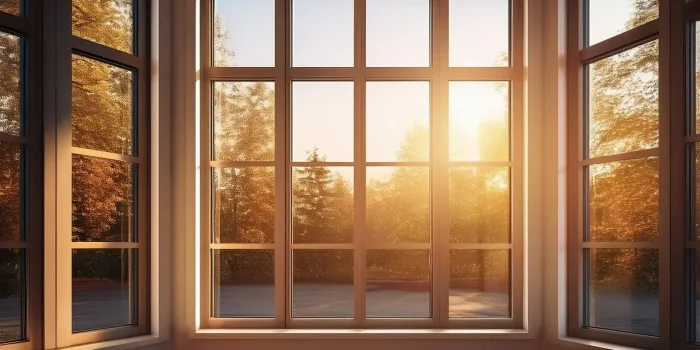Imagine living in a home that’s cozy in the winter, cool in the summer, and saves you money all year round. This isn’t just a pipe dream—it’s the reality of a home with windows that have excellent energy ratings.
Understanding window energy ratings might seem like a daunting task, but it’s simpler than you think. These ratings are a key factor in determining how energy-efficient your windows are.
In this article, we’ll demystify window energy ratings and guide you through understanding their importance. So, whether you’re planning a renovation or just curious, you’re in the right place to learn more.
Understanding Window Energy Ratings
Let’s delve deeper into the heart of window energy ratings, a critical component of an energy-efficient home.
What are Window Energy Ratings?
Window Energy ratings are a benchmark to ascertain the energy performance of various windows. These standardized measures enable homeowners to evaluate the overall efficiency of their windows and make an informed decision while investing in home renovations. A key element in this rating system is the National Fenestration Rating Council (NFRC) label.
To put it in layman’s terms, the NFRC label is like the nutrition label on your food package, but for windows. It breaks down the energy performance ratings in different categories, thus, allowing a side-by-side comparison of various energy-efficient windows.
What do these ratings look like? The key metrics you would find on an NFRC label are:
- U-Factor: This metric gauges the insulation quality of the window, i.e., its ability to resist heat loss. The lower the U-Factor, the better the insulation. The U-Factor generally falls within the range of 0.20-1.20.
- Solar Heat Gain Coefficient (SHGC): This metric indicates the capacity of your window to resist unwanted solar heat gain. Now, lower values are to your advantage if you live in a warmer climate, while higher values are beneficial in colder weather as it facilitates warming by solar heat. The SHGC typically falls within the range of 0-1.
Why are Window Energy Ratings Important?
Energy-efficient windows play a pivotal role in optimizing your home’s energy performance, thereby reducing energy costs. Given increasing energy costs and growing environmental consciousness, a window’s energy rating has become an essential consideration for homeowners.
By understanding these ratings, you can choose windows that provide the optimal balance between comfort and energy efficiency. This effectively lowers your overall demand for heating and cooling appliances, leading to considerable energy cost savings. Just as an example, potential savings in homes with highly rated windows can reach $500 annually.
Besides, an efficient window system also diminishes your carbon footprint, contributing to wider environmental conservation efforts. So in essence, a good grasp of window energy ratings helps you make tailored choices for your unique circumstances, creating a more comfortable, cost-effective, and eco-friendly living space.
The Basics of Energy-Efficient Windows
As our journey towards understanding window energy ratings continues, let’s delve into two more aspects that profoundly impact the energy efficiency of windows – window glazing and frames.
The Role of Window Glazing
When it comes to boosting window energy efficiency, glazing plays a pivotal role. The term “glazing” simply refers to the glass part of a window. It comes in single, double, and even triple panes, each with their unique energy implications.
- Single-pane windows are pretty much old school now. They offer the least thermal insulation, leading to notable heat loss in chilly weather and allowing heat to creep in during summertime.
- Double-pane windows, on the other hand, are the standard these days. They consist of two glass layers with a tiny space in-between, often filled with an insulating gas like argon.
- Triple-pane windows, as their name suggests, bring along an additional glass layer. They’re the pros of the game, providing top-notch insulation but at a higher cost.
It’s all about trade-offs, so choose based on your budget, climate, and insulation needs.
The Impact of Window Frames on Energy Efficiency
Your window frame is more than just a beautiful house accessory. It can significantly dictate your window’s energy efficiency, depending on its material.
- Aluminum frames are durable and require little maintenance, but they conduct heat quickly, making them a less ideal choice for energy efficiency.
- Wooden frames rank high on the insulation scale, but they demand regular upkeep to prevent warping or rotting over time.
- Vinyl frames strike a balance with decent insulation capabilities and better weather resistance. However, they might limit you in color and style choices.
- Fiberglass frames, although slightly more expensive, provide great insulation and require low maintenance.
It’s essential to pair the right glazing and frame for ultimate window energy efficiency. Always consider the NFRC ratings while making your choice. These decisions directly impact not just the comfort of your home but also its yearly energy expenses.
Decoding Window Energy Ratings
Let’s delve deeper into understanding window energy ratings after grounding ourselves in the basics. Here, we’re going to break down and demystify some crucial metrics defined by the National Fenestration Rating Council (NFRC).
U-Factor: Understanding its Significance
U-Factor measures a window’s insulation quality. Precisely, it represents the rate of heat transfer from warm to cold areas, essentially telling you how well a window retains heat. It’s typically gauged in units of Btu/h x sq. ft. x °F or watts per square meter Kelvin (W/m²K). Make sure to note that a lower U-Factor translates to better insulation properties. So, if a window boasts a U-Factor of 0.25(W/m²K), it’s excellent at reducing heat loss during winter and keeping out heat in the summer.
Solar Heat Gain Coefficient (SHGC): What it Means
Switching gears to SHGC, it’s all about the amount of solar heat a window permits. If the SHGC measure is closer to zero, that means less solar heat is transmitted, keeping your space cooler. Conversely, a window with an SHGC closer to one allows more solar heat, meaning a warmer interior. A window with an SHGC of 0.6, for instance, lets in a significant amount of solar heat.
Visible Transmittance (VT): Its Impact on Energy Efficiency
Visible Transmittance (VT) is another metric you’ll encounter, and it’s remarkably different from the two we dissected earlier. VT measures how much available light a window lets in. It ranges from 0 to 1, with a higher VT meaning more light transmission. A window with a VT of around 0.65, for example, allows plenty of natural light to brighten up your rooms. Coupling a high VT window with a low SHGC can strike a balance between light and heat, enhancing your living comfort and energy savings.
Air Leakage (AL): Why it Matters
Air Leakage (AL), as the name suggests, quantifies the amount of air that seeps in and out through window cracks. An energy-efficient window should have a low AL. With an excellent AL value of 0.1, for example, air infiltration through the window is kept minimal, preventing drafty situations and maintaining indoor temperature stability.
Condensation Resistance (CR): A Critical Factor
Lastly, let’s not forget about Condensation Resistance (CR). CR determines a window’s ability to resist condensation buildup. Graded between 1 and 100, a high CR score implies less chance of condensation, contributing to maintaining good visibility and healthy indoor air quality. Opting for a window with a high CR (say, 65) can keep the moisture at bay, especially in humid climates.
How To Read Energy Performance Labels
Understanding energy performance labels is a crucial first step towards greater home comfort and energy savings. Here’s a quick walkthrough on how to interpret two key labels: the National Fenestration Rating Council (NFRC) and ENERGY STAR.
National Fenestration Rating Council (NFRC) Labels
NFRC labels are your window’s report card, offering an unbiased, third-party assessment of its energy performance. Here’s how you decipher it:
- U-Factor: If insulation is your game, pay close attention to the U-Factor. This number measures how well your window prevents non-solar heat loss or gain. The U-Factor typically ranges between 0.20 and 1.20. The trick is: the lower the score, the better the window is at insulating your home.
- Solar Heat Gain Coefficient (SHGC): Want to control the sun’s heat? Turn your focus to the SHGC rating. This number tells you how much solar radiation can squeeze through your window. The values range from 0 to 1. A lower SHGC score is your friend in hot climates, where it keeps the scorching sun out. On the flip side, a higher SHGC score lets in the winter sun, offering a natural heat source in colder climates.
ENERGY STAR Labels
Stay tuned as we delve deeper into ENERGY STAR labels, make sense of their ratings, and learn how they complement NFRC labels to guide your window choices.
Different Types of Energy-Efficient Windows
When it comes to preserving your home’s comfort while reducing energy consumption, the type of windows you choose matters. Taking a deeper dive into the key types of energy-efficient windows gives you a clearer picture of the best option for your home.
Double-Pane Windows and Their Ratings
Perhaps the most common type of energy-efficient window is the double-pane. Comprising two layers of glass separated by a space filled with air or inert gas, these windows form an insulating barrier against heat transfer.
- U-Factor: For double-pane windows, U-Factors tend to range from a striking 0.30 to a higher 0.50, with the lower numbers yielding the best insulation and preventing the most heat loss.
- Solar Heat Gain Coefficient (SHGC): These windows have SHGC values varying from 0.30 to 0.60. If you’re living in a hot climate, look for a lower value to minimize cooling loads. If your home is on the chillier side, a higher value benefits by capturing more solar heat.
- Visible Transmittance (VT): Giving a gauge of the visible light allowed through the window, VT for double-pane windows usually oscillates between 0.5 and 0.7.
Triple-Pane Windows and Their Ratings
If you’re looking for an upgrade, consider the triple-pane window. They feature three layers of glass, creating two separate air or gas-filled spaces for increased insulation.
Low-Emissivity (Low-E) Windows and Their Ratings
As technology advances, so does window efficiency. Low-emissivity or “Low-E” windows feature a special coating that reflects infrared light, keeping heat inside in the winter and outside in the summer. These innovative windows offer an advanced option in energy efficiency.
You’ve now been introduced to varied energy-efficient window types to align with differing climatic needs. Understanding the ratings helps you strike a balance between comfort and efficiency, so consider these options carefully when choosing your home windows.
How Window Energy Ratings Affect Your Home
While you might be familiar with the cost-saving potential of energy-efficient appliances, did you know your windows play a significant role too? Based on your understanding of window energy ratings from previous sections, let’s dive further into how these ratings impact your home.
Energy Savings Potential with High-Rated Windows
Often, a home’s energy efficiency gets overlooked in the excitement of decor and design. But it’s something you can’t afford to miss. Window energy ratings are a key determinant of this efficiency, providing you with a way to measure how well your windows perform.
For instance, consider metrics like U-Factor and Solar Heat Gain Coefficient (SHGC) as defined by the National Fenestration Rating Council (NFRC). Low U-Factor values indicate better insulation properties, and low SHGC values mean the windows resist solar heat gain more effectively. A window that excels in these metrics significantly reduces your energy consumption, creating a cozy indoor climate without overworking your HVAC system. The U.S. Department of Energy estimates energy-efficient windows can save you between $126 to $465 a year.
Impact on Indoor Comfort Levels
It’s not just about energy savings and cost-cutting. High-rated windows ensure a comfortable indoor environment as well. A lower U-Factor means less heat transmission, keeping your home warmer in winter and cooler in summer. This translates to consistent indoor temperatures with fewer drafts and cold spots.
Similarly, the Visible Transmittance (VT) metric indicates how much visible light your window lets in. With a good balance between VT and SHGC, you can bask in sunlight without uncomfortable heat in summer. By keeping out the wind and controlling the daylight entering, windows contribute significantly to the tranquil ambiance of your home.
Relationship Between Window Energy Ratings and Climate
The National Fenestration Rating Council (NFRC) rating also includes integral performance aspects like Air Leakage (AL) and Condensation Resistance (CR). Low AL value ensures less air escapes through the window, crucial in cold climates. High CR indicates your windows do a top-notch job of resisting condensation, a key aspect in humid environments.
But remember, the ideal energy rating varies based on your local climate. For example, warmer climates require windows with low U-Factors and SHGC values to keep the heat out, while in colder climates, higher SHGC values are desirable for warmth. Hence, understanding these ratings helps you choose windows that are truly net-positive for the environment and your wallet.
Making the Right Choice: Tips for Choosing Energy-Efficient Windows
Having a wealth of knowledge about window energy ratings is a great starting point, but delving deeper into the specifics makes your window purchasing decision more accurate and personalized. Let’s dig into more detailed tips to help you make the right energy-efficient window choice.
Considering Your Geographic Location
Your geographic location and the local climate play an integral role in your choice of energy-efficient windows, specifically in the selection of U-Factor and Solar Heat Gain Coefficient (SHGC) values.
- Cooler Climates: If you live in colder areas, like Alaska or North Dakota, where average winter temperatures often plummet below freezing, aim for windows with a lower U-Factor (0.30 or less), which measures heat loss and helps keep your home toasty. Additionally, a higher SHGC value (0.40 or more) encourages more solar heat, minimizing heating costs.
- Warmer Climates: For hotter regions like Arizona or Florida, where summer temperatures can often exceed 100°F, selecting windows with a lower SHGC (0.30 or less) keeps unwanted solar warmth out, reducing cooling expenses. Though a lower U-Factor is still beneficial here, it may not be as crucial as in chillier climates.
Balancing Cost with Energy Efficiency
Energy-efficient windows are an investment. While the initial costs may seem steep, the long-term savings on energy bills can lead to an overall reduction in costs. Research shows that, regardless of your home’s location, you can expect to save between $126 to $465 per year with energy-efficient windows, as compared to traditional models.
Prioritizing Essential Rating Factors
When choosing your energy-efficient windows, prioritize two essential rating factors:
- U-Factor: Aim for a lower U-Factor, especially if you live in a cooler climate. Lower U-Factor values promise better thermal insulation, reducing heat loss.
- Solar Heat Gain Coefficient (SHGC): Depending on your climate, your SHGC preference may vary. Lower values are ideal for warmer climates, while higher values may prove beneficial in cooler climates.
By meticulously considering your geographic location, balancing costs with efficiency, and prioritizing essential rating factors, you’re well on your way to making a savvy, energy-efficient window choice that cuts energy costs and enhances comfort in your home. Remember, a well-informed purchase decision pays dividends in the long run.
Maintaining the Energy Efficiency of Your Windows
Having gained knowledge about window energy ratings, it’s time to switch gears and focuse on how you can maintain the energy efficiency of your windows. Here, we’ll discuss regular maintenance tips for your windows and how to recognize when they need replacement.
Regular Window Maintenance Tips
- Keep Your Windows Clean: Dirt and dust can reduce the effectiveness of your windows’ insulating properties. Regular cleaning will not only keep them looking their best but also enhance their energy efficiency. Try to clean your windows at least once every six months.
- Regularly Check for Leaks: Small cracks and leaks in your windows can significantly increase energy loss. Be proactive in inspecting your windows for any leaks, sealing them immediately with caulk or weather stripping to prevent heat loss.
- Ensure Good Ventilation: Proper ventilation can help prevent condensation, which may lead to mold growth and window damage. Regularly opening your windows, when weather permits, will promote airflow and help to maintain their efficiency.
- Utilize Window Treatments: Using window treatments like blinds and curtains can help regulate your home’s temperature, reducing the strain on your windows. In the hotter months, closing blinds can help keep out excess sunlight and reduce heat gain.
Recognizing When to Replace Your Windows
Homeowners typically replace their windows every 15 to 20 years, but various factors can speed up this process. Here are a few signs that you may need to replace your windows sooner:
- High Energy Bills: If you notice significant jumps in your energy bills without a corresponding change in your usage, it may indicate your windows are no longer functioning efficiently.
- Physical Damage: Obvious physical wear, such as warping, broken glass, or decay, may mean your windows need replacing.
- Difficulty Opening/Closing: If your windows are difficult to open or close, it’s often a sign that they no longer fit properly in their frames.
- Condensation Buildup: Frequent condensation between window panes can be an indication of a broken seal and a key sign that window replacement is necessary.
By keeping up with regular maintenance and being vigilant for signs of wear, you can extend the life of your windows and ensure they continue to contribute positively to your home’s energy efficiency.
Conclusion: The Power of Window Energy Ratings
Understanding window energy ratings is an empowering tool for homeowners. It’s a guide to creating a home that’s not only comfortable but also cost-effective and eco-friendly. With the insights gained from these ratings, you’re equipped to make informed decisions about window glazing and frames, potentially saving hundreds of dollars on energy bills annually.
These ratings also guide you in selecting the right type of energy-efficient windows for your specific climate needs. They enable you to balance initial costs with long-term savings, ensuring that your investment is worthwhile.
But remember, it doesn’t stop at selection and installation. Regular maintenance and timely replacements are key to maintaining your windows’ energy efficiency. By keeping your windows in their best condition, you’re ensuring they continue to contribute positively to your home’s energy efficiency.
So, harness the power of window energy ratings. Create a comfortable, cost-effective, and eco-friendly living space that’s perfect for you.





